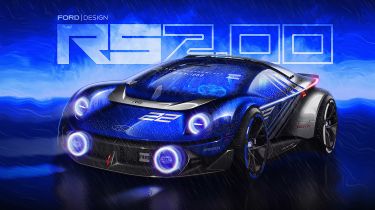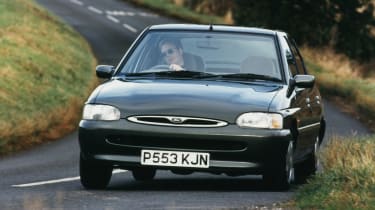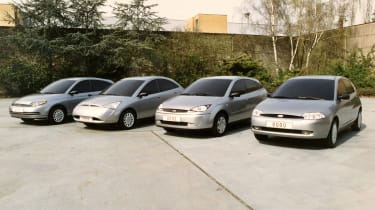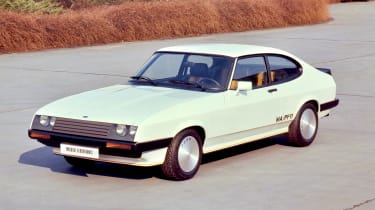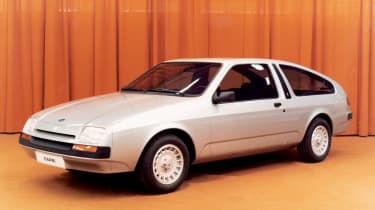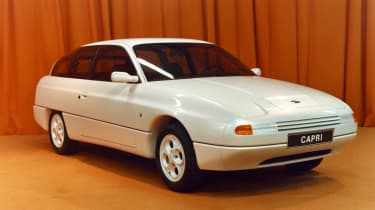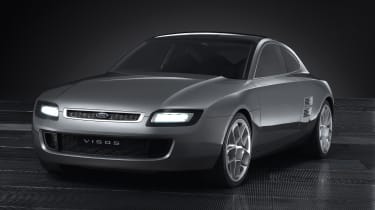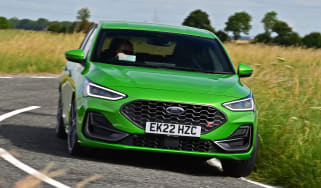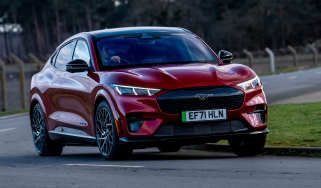Secret cars Ford never built: from the RS200 successor to the new Escort
A new book delves behind the scenes at Ford to reveal the reimagining of its Group B monster, plus the company’s struggles to replace the ageing Escort with a fresh new design
Ford has a long history in motorsport, including many iconic race and rally winners. But as the company shifts towards a more sustainable future, how can it hope to excite a new generation with electric models? One potential answer has been provided by the company’s European design team, as part of a tie-in with a new book revealing some of Ford’s most secret projects from the eighties and nineties.
Mid-engined, four-wheel drive and turbocharged, the RS200 was conceived as Ford’s rally challenger for the all-conquering Audi Quattro. But the radical creation was launched late in the life of the spectacular Group B era, and it contested only a handful of World Rally Championship rounds in 1986 before the category was banned. Just 200 were produced, to comply with homologation requirements.
Last summer, Ford’s European design boss, Amko Leenarts, asked his team members to submit their vision for how a modern, all-electric RS200 could look. A number of concept drawings feature in a special edition of the latest book from motor industry insider Steve Saxty – Secret Fords Volume Two – and one of the entries, seen here, was chosen to feature on the design department’s 2021 Christmas card.
The Vision RS2.00 is a dramatic-looking vehicle with clear influences from the original car – notably the round headlights and lower foglights. Its designer, former Kia man Michael Barthly, says he created the car “to respect the RS200’s DNA, but with a futuristic twist”. It’s envisaged as a vehicle that could be chosen and driven in a computer game – similar to the Extreme P1 that Ford officially released through its online racing community in 2020.
As such, the design features ‘holographic’ and slightly pixellated Hella foglights in the front bumper, as well as an ‘audio blade’ in the bonnet that creates noise as air rushes through it. The spoiler – whose presence in the side profile is perhaps the strongest nod to the original Ghia-designed RS200 – incorporates a wraparound tail-light, and there are cooling slats in the rear bodywork. The car carries a modified version of Ford’s mid-eighties motorsport livery, too.
“Because the original is so strongly linked to its era,” Barthly said, “I thought it was important to imagine a new car that could become an icon for future generations. The Vision RS2.00 plays with the RS200’s pedigree, while offering twists to make it a digital racer that a new generation of race car lovers would find efficient and entertaining to play with.”
There are no plans within Ford to build a vehicle like the RS200. The original was assembled by fibreglass specialist Reliant, and used borrowed components from the Sierra. But the car was a financial disaster, and it would arguably be even more costly to develop now. In addition, the concepts in the book are understood to be a design department exercise, not officially sanctioned by Ford’s marketing and product divisions.
But Leenarts and his team did go to some trouble for the internal unveiling of RS2.00 and three other ideas from the same project, all of which feature in Saxty’s book. An original RS200 was at the event – the first time a car from the eighties had been inside Ford’s inner design sanctum in decades.
Saxty himself says, “The team had hoped to build RS2.00 as a full-sized model, but Covid-19 got in the way. We can only hope that one day soon things will ease up and we’ll get to see these dreams come off the page and into 3D.”
In the meantime, it’s conceivable that Ford could choose to revisit the RS200 in digital form. As Ford’s boss Jim Farley told us, at the reveal of the Extreme P1, “Motorsport is such a fundamental part of what we do when we wake up at Ford. We’re not in a lot of forms of racing now, intentionally, but I believe the virtual world is the most important area for us to develop new thinking that applies to our production vehicles.
“I wouldn’t say I’d expect to sell a bunch of vehicles because we’re in virtual racing. I’d turn it around and say that just as we invested in motorsports all those years ago, because we wanted to make better vehicles, it’s the same nowadays with virtual. The digital experience in vehicles has become perhaps the most important differentiator these days.”
The Ford Focus was a revelation when it arrived in 1998, marking a sea change in approach, design and execution after the unloved Mk6 Escort. But Steve Saxty’s latest deep-dive into the Ford archives has revealed that the project was actually a relatively last-minute switch, and that the company went some way down the line of developing a Mk7 Escort before having an epiphany on design.
Revealed for the first time in Secret Fords Volume Two, this vehicle, codenamed CE99, was expected to continue the Escort bloodline. It features a more practical shape than the sixth generation of the car, and incorporates a few elements of the ‘New Edge’ design language that had been introduced on the Ford GT90 concept, and then the Ka.
Ford’s engineers had gone a long way to sharpening up their next Golf rival’s chassis, but their colleagues in the design department had been struggling to work out how to give the Escort best-in-class packaging, while still keeping the hatchback shape that was popular with buyers. Earlier efforts to free up more cabin space had resulted in cars that looked more like SUVs or even boxy MPVs.
CE99 was considered the best compromise on this score – but several senior Ford figures, including boss Jac Nasser, were dissatisfied with progress. Then a young designer called Boris Jacob, only 28 years old and just a year out of college, was given the chance to play with the shape.
His vision of the rear three-quarter of the vehicle – uncovered by Saxty for the book – was to prove a pivotal moment, because it gave the wider Ford team fresh belief that they could raise the car’s roofline without making it look like a people carrier. Even today, the drawing is referred to by senior Ford figures as “the X sketch” – because of its significance as much as Jacob’s use of intersecting triangular shapes.
Even the first clay model based on the X sketch is clearly recognisable as the Focus that was to come – now codenamed CW170 – although of course, Ford played with a number of treatments in key areas. The final four alternatives are seen here for the first time, lined up for consideration in the courtyard of Ford’s European design centre in Merkenich, Germany.
The leftmost vehicle’s flanks are partially hidden, but you can see a clear crease running from the tip of the headlight, along the doors and all the way to the C-pillar. This was meant to give the car a tangible link to the previous Escort, but ultimately, chief program engineer Tony Pixton recalls, this motif “detracted from the purity of the design”.
The next concept along has an even more controversial front-end treatment – almost as if someone had been asked to incorporate US-market impact bumpers and decided to make a feature out of it. The car on the far right has different approaches to both of its sides, as the designers played with surfacing to see how lines could join the wheelarches to the base of the vertical tail-lights.
The remaining car is, of course, the Focus that entered production – and amazingly this model was created just two months after the first rough clay made from Jacob’s sketch. The young German went on to enjoy spells at Volkswagen and Opel, and now works at Stellantis. And the first-gen Focus revitalised Ford’s fortunes against the Golf and Vauxhall Astra, as well as introducing a sharp-edged approach to design whose influence is still being felt today.
Secret Fords by Steve Saxty
Steve Saxty’s second book on Ford’s secret history (above) includes hundreds of previously unseen images revealing the detailed background behind some of the firm’s most famous models. Secret Fords Volume Two is available in a number of different editions, including a special RS version that features the reimagined RS200s. The books are available to order at stevesaxty.com.
More secret Fords you've never heard of
MA/PF-11 Modular Capri
This design study was actually created in 1976, when Ford tried to spice up the fairly bland Mk2 Capri into something that would have more appeal with the original car’s customer base. It was, in fact, shown to the public at the 1976 Geneva Motor Show – but drew little attention because the press was focused on the forthcoming new Fiesta and Cortina.
MA/PF-11 was a bit of a design mash-up that took elements from the existing Mk2 Capri and grafted on cues from the Escort RS2000 – most notably that car’s vane front grille, made all the cleaner on the Capri concept by the placement of the Ford badge on the leading edge of the bonnet above.
Other show-car elements included 17-inch wheels (normal today, but giant in comparison with the Capri’s usual 13-inch items back in 1976), a rear spoiler and a moulding over the top of the A-pillar, designed to give the car a smoother overall look.
The MA/PF-11 concept you see here didn’t make it through to production unchanged, but Ford’s Swiss designer Heinz Berhalter tweaked the front grille and simplified the rear spoiler to give it a more elegant look, without the show car’s long nose.
It worked, too; the resulting Mk3 Capri, which was introduced in 1978, lasted all the way through until the final examples of the car were delivered in 1987.
Ghia’s ‘Sierra Capri’
One of four never-before-seen Ghia studies featured in Saxty’s book, this model was created in September 1980, just a few months after the Sierra had been signed off, but still almost two years before the controversial Cortina replacement would actually reach production.
The Ford-owned consultancy was given a brief to shake up the established design process by coming up with left-field alternatives to the mainstream models – and it certainly did that with this concept. The proposed Mk4 Capri took its windscreen and headlights from the Sierra, plus the doors from the three-door version of that car.
The key element in the car’s profile was the blacked-out panel on the B-pillar, because it allowed Ghia’s team to shorten the rear window a little in a bid to give the car more of a coupé look instead of remaining too much of a three-door family car. A little surfacing, low down on the flanks, helped to reduce the visual mass of the side panels, too.
With the Sierra’s rear-drive chassis beneath it, and the potential for V6 power or even four-wheel drive, this model could have been a fascinating proposition for a Mk4 Capri; the shared underpinnings could have helped Ford to keep down costs, too. But the market had already started to move towards smaller, more fuel-efficient coupés like the VW Scirocco, and hot hatches such as the VW Golf GTI – so Ghia’s efforts never made it beyond this early stage.
Capri Kammback
Behold the Capri Kammback, which took the Mk3 Escort XR3 as its inspiration instead of the Sierra. This radical-looking concept was Ghia’s fourth and final attempt at making a Capri, created with the following (self-provided) brief: “This proposal has a unique and distinct personality – combining the sporty image of the Capri with the functional characteristics of a station wagon [estate car]. The Capri Kammback features seating for four, with access through the tailgate or through the centre-hinged wrapover quarter window, allowing easy kerbside loading.”
The resulting vehicle is unlike anything seen in Ford’s back catalogue, with even the longer main doors dwarfed by the slab of bodywork running from B-pillar to tail, supporting a complex glass structure that would have been potentially ruinous to make. The telltale design cue on this model – apart from those XR3 alloys – is the rising beltline, which is meant to highlight the switch to front-wheel drive.
The radical Kammback looks a long way from a traditional Capri replacement – but it was considered seriously enough for it to be flown to the United States for aerodynamic testing. Indeed, the two Ghia models featured here are among the most secret design studies to feature in Saxty’s book, because the codes on the few images unearthed of them would indicate that they were shipped direct from the firm’s workshops in Turin to Dearborn in the US. So they bypassed all of Ford’s European design know-how – becoming, to some extent, secret cars within Ford itself.
Incidentally, the images reveal that this was proposed as ‘Capri III’ – a reflection of how Ford never referred to the Mk3 Capri by that designation. The company always believed that the model that ran from 1978 to 1987 was the facelifted Mk2.
Project S272/Visos
As things stand, this car is where the Capri story ends – because Project S272 marked the last serious attempt to bring the nameplate back to life. The car’s existence was inextricably linked to Martin Leach, who became Ford of Europe’s president in 2002. The British exec had seen ‘retro-modern’ cars like the reborn MINI and Beetle, BMW’s Z8 and Ford’s own Thunderbird, and he decided that the time was right for the Capri name to return.
Ford’s designers, led by J Mays and Chris Bird, approved a concept created by Chris Svensson (father of the original Puma and first Ka). Called Visos, it assumed that customers wouldn’t want a pastiche of an old Capri, but rather a more sophisticated, forward-looking sports coupé.
As such, the concept was clearly based on a relatively small platform – in this case, the Focus’s – although thanks to the three-door bodystyle, it was easier to draw similarities with the Volvo C30, which also used the same architecture. However, Ford claimed a more ambitious powertrain than those cars’, proposing a twin-turbo six-cylinder engine producing 350bhp, and four-wheel drive.
The design had a neat front end that subtly referenced the Capri’s multi-headlight arrangement, and also incorporated an upturned hockey-stick side swage, dummy air vents just ahead of the rear wheels, and unusually muscular rear shoulders for such a small model.
The Visos was in fact displayed at the 2003 Frankfurt Motor Show, where Ford insiders did their best to hint to media that the car could be the “new Capri”. The firm even trotted the concept (freshly repainted in metallic green) out for test drives by the motoring press, including Auto Express, which concluded that the car had solid potential to be a halo model for the rest of the Ford range.
Plans for a production version took a hit, though, when research showed that while potential buyers liked the Audi-esque sophistication, they wiped £10,000 off their expected price when they realised it was a Ford.
In the end, Leach left Ford just as the Visos concept was being released. As a result, Project S272 lost momentum at a crucial stage, and any hope of the Capri name returning died with it. For the time being, at least.
Click here for our list of the greatest fast Fords ever....
Find a car with the experts

